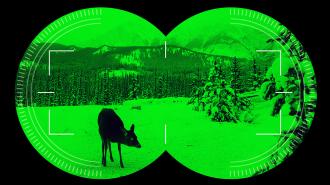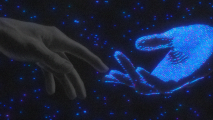Using deep learning AI, researchers at UC Irvine (go anteaters!) have shown a proof-of-concept for full-color night vision.
Their AI was able to turn three images taken using only infrared light and colorize them pretty close to the scenes’ true colors, Interesting Engineering reports.
“You can imagine this having military applications, or just recreational applications to see at night,” study lead author Andrew Browne, an engineer, surgeon, and vision researcher at UCI, told IEEE Spectrum.
“You can also imagine this finding use in chemical processing, where people need to work in places that are sensitive to visible light, or in medical or research situations where one has to work with light-sensitive retinal tissue.”
Using deep learning AI, researchers have created a proof-of-concept for full-color night vision.
Sights unseen: So, you obviously can’t see in the dark, right?
But that’s not always due to a complete lack of light. The human eye can only see a narrow band of the light spectrum, from red to violet; wavelengths outside of that range are invisible to us.
A sealed room with a lamp blasting infrared light would still look pitch black to the unaided eye.
Which is where infrared night vision comes in.
While our eyes can’t see outside of our visible light spectrum, technology can. Some night vision systems see in infrared light and render it into visible light, usually in one color.
That color often ends up a sickly, action movie green, because that’s the wavelength our eyes are most sensitive to, the Daily Beast explains. If you want night vision that’s not green, there are ultra-sensitive cameras that can glean and amplify visual light rather than infrared, but using visible light in scientific experiments can damage vulnerable tissues and specimens.

Towards full-color night vision: “This began when I was sitting and thinking, ‘Is there a way to do everything in the dark?’” Browne told Spectrum.
The Irvine researchers turned to training a deep-learning algorithm.
For their proof-of-concept study, published in the journal PLOS One, the team began by taking a bunch of photos of color palettes and faces using monochromatic light sources, both with various visible lights and infrared, Interesting Engineering reports.
AI looked at all of these labeled images and learned to predict how an infrared image from a night vision camera would look in full color.
To test it, the AI was shown 20 faces lit only with near-visible infrared light, Spectrum reported, which it successfully reproduced in true, visible-light colors.
Work in progress: Even in this very narrow case, the results weren’t perfect — and importantly, the AI’s predictions are limited to what it’s been taught.
“There is some variability because you can put them side-by-side and see some differences here and there,” Browne told the Daily Beast. “[But they’re] basically indistinguishable like you wouldn’t even know you were looking at a predicted image.”
While far from ready for the battlefield, the tech may eventually have applications beyond the obvious military ones.
While far from ready for the battlefield, the tech will eventually have applications beyond the obvious military ones, Spectrum reports.
“You can also imagine this finding use in chemical processing, where people need to work in places that are sensitive to visible light, or in medical or research situations where one has to work with light-sensitive retinal tissue.”
We’d love to hear from you! If you have a comment about this article or if you have a tip for a future Freethink story, please email us at [email protected].






